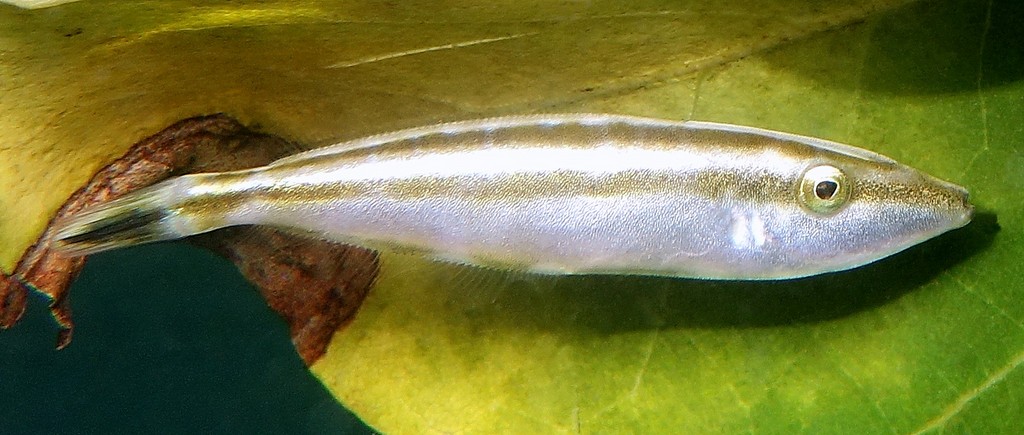PSEUDALUTARIUS NASICORNIS - (TEMMINCK & SCHLEGEL, 1850)
Picture courtesy of: Jack Berthomier (Flicker)
Actinopterygii (Gigaclass) > Actinopteri (Class) > Teleostei (Subclass) > Tetraodontiformes (Order) > Balistoidei (Suborder) > Monacanthidae (Family) > Pseudalutarius (Genus)
Poisson-lime rhinoceros, Rhinoceros leatherjacket, Rhinoceros filefish, Rhino leatherjacket, Rhino filefish, Rhino file-fish, Renoster-leerbaadjie, Hanatsunohagi, ハナツノハギ 물각쥐치, 前棘假革魨,
Synonymes
Alutera nasicornis (Temminck & Schlegel, 1850)
Aluteres nasicornis (Temminck & Schlegel, 1850)
Aluterus nasicornis (Temminck & Schlegel, 1850)
Aluterus rhinoceros (Hollard, 1855)
Pseudalulerius nasicornis (Temminck & Schlegel, 1850)
Pseudalutarias nasicornis (Temminck & Schlegel, 1850)
Pseudaluteres nasicornis (Temminck & Schlegel, 1850)
--------------------------
Description
Dorsal spines (total): 2; Dorsal soft rays (total): 43-50; Anal soft rays: 41-46; Pectoral fin rays: 11-13 (usually: 10-12); Relatively slender body, depth at level of origin of anal fin about 6.0 in SL in juvenile and about 3.5 in SL in adult male; Very low second dorsal and anal fins; Convex snout profile, especially in male. Pelvic fin rudiment and ventral flap absent; First dorsal spine very slender, origin anteror to eye. Second dorsal-fin spine long, slender; Second dorsal and anal fins very low; Caudal fin short, rounded. Mouth small, terminal. Jaw teeth long, incisiform. Eye moderately large. Max. length: 19.0 cm TL. Depth range: 1 - 55 m.
Color
Body silvery grey to pale brown or white, with 2 longitudinal yellow-brown stripes along upper sides (juveniles and small adults), occasionally replaced by broader brownish stripes in some individuals; Adults may also develop many tiny yellow spots on head and body (most prominent in males); Soft-rayed dorsal fin and anal fin hyaline to pale brown; Caudal fin more whitish, with large brown to black blotch covering centre of fin.
Etymology
Pseudalutarius: from Greek, pseudes = false + from Greek, luteria, luter, luteros = one who looses, deliverer. Aluterus or aluteres meaning not free or detached. Not representing the true form of Alutarius (=Aluterus, original genus of P. nasicornis), with dorsal spine well in advance of eye instead of over middle of eye.
nasicornis: from Latin, nasus = nose + from Latin, cornū = horn. Referring to dorsal spine well in advance of eye (on upper snout) instead of over middle of eye.
Original description: Alutera nasicornis Temminck & Schlegel, 1850 - Type locality: no locality stated (Nagasaki, Japan).
Distribution
Indo-West Pacific: Eastern Cape and KwaZulu-Natal (South Africa), East Africa, Seychelles, Madagascar and western Mascarenes (La Réunion, Mauritius), east to New Guinea, north to southern Japan, south to Australia and New Caledonia.
Biology
Inhabit coastal reefs and enter estuaries. Often in silty habitat and usually on slopes with low rubble reef and rich invertebrate growth, ranging to moderate depths. Often found in pairs. Sometimes solitary or in groups. Juveniles hide or shelter near seawhips or seapens. Aquarium fish.
Last update: 4, April 2024
Poisson-lime rhinoceros, Rhinoceros leatherjacket, Rhinoceros filefish, Rhino leatherjacket, Rhino filefish, Rhino file-fish, Renoster-leerbaadjie, Hanatsunohagi, ハナツノハギ 물각쥐치, 前棘假革魨,
Synonymes
Alutera nasicornis (Temminck & Schlegel, 1850)
Aluteres nasicornis (Temminck & Schlegel, 1850)
Aluterus nasicornis (Temminck & Schlegel, 1850)
Aluterus rhinoceros (Hollard, 1855)
Pseudalulerius nasicornis (Temminck & Schlegel, 1850)
Pseudalutarias nasicornis (Temminck & Schlegel, 1850)
Pseudaluteres nasicornis (Temminck & Schlegel, 1850)
--------------------------
Description
Dorsal spines (total): 2; Dorsal soft rays (total): 43-50; Anal soft rays: 41-46; Pectoral fin rays: 11-13 (usually: 10-12); Relatively slender body, depth at level of origin of anal fin about 6.0 in SL in juvenile and about 3.5 in SL in adult male; Very low second dorsal and anal fins; Convex snout profile, especially in male. Pelvic fin rudiment and ventral flap absent; First dorsal spine very slender, origin anteror to eye. Second dorsal-fin spine long, slender; Second dorsal and anal fins very low; Caudal fin short, rounded. Mouth small, terminal. Jaw teeth long, incisiform. Eye moderately large. Max. length: 19.0 cm TL. Depth range: 1 - 55 m.
Color
Body silvery grey to pale brown or white, with 2 longitudinal yellow-brown stripes along upper sides (juveniles and small adults), occasionally replaced by broader brownish stripes in some individuals; Adults may also develop many tiny yellow spots on head and body (most prominent in males); Soft-rayed dorsal fin and anal fin hyaline to pale brown; Caudal fin more whitish, with large brown to black blotch covering centre of fin.
Etymology
Pseudalutarius: from Greek, pseudes = false + from Greek, luteria, luter, luteros = one who looses, deliverer. Aluterus or aluteres meaning not free or detached. Not representing the true form of Alutarius (=Aluterus, original genus of P. nasicornis), with dorsal spine well in advance of eye instead of over middle of eye.
nasicornis: from Latin, nasus = nose + from Latin, cornū = horn. Referring to dorsal spine well in advance of eye (on upper snout) instead of over middle of eye.
Original description: Alutera nasicornis Temminck & Schlegel, 1850 - Type locality: no locality stated (Nagasaki, Japan).
Distribution
Indo-West Pacific: Eastern Cape and KwaZulu-Natal (South Africa), East Africa, Seychelles, Madagascar and western Mascarenes (La Réunion, Mauritius), east to New Guinea, north to southern Japan, south to Australia and New Caledonia.
Biology
Inhabit coastal reefs and enter estuaries. Often in silty habitat and usually on slopes with low rubble reef and rich invertebrate growth, ranging to moderate depths. Often found in pairs. Sometimes solitary or in groups. Juveniles hide or shelter near seawhips or seapens. Aquarium fish.
Last update: 4, April 2024
